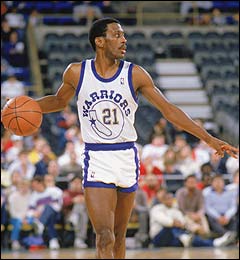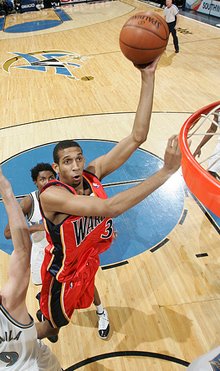
I'm no salary cap expert, but I've tried to make sense of the upcoming cap situations for the next couple of seasons. Armed with Larry Coon's '
NBA Salary Cap FAQ' and
hoopshypes salary breakdowns, hopefully I could shed some light on options for Mullin as the fabled Free Agency crop of 2010 slowly approaches.
Contrary to popular belief, the Warriors will not be blessed with a windfall of cap space in 2010 when Harrington and Jackson's deals expire. They will be under the cap but there will be significant obstacles to overcome in order to be able to sign a 'Max' deal for one of the top free agents.
2009-2010Roster and salaries going into 2009 offseason:
Ellis : $11.0
Harrington : $10.0 (P.O.)
Biedrins : $9.0
Maggette : $8.9
Jackson : $7.7
Turiaf : $4.2
Azubuike : $3.1
Wright : $2.7 (T.O.)
Williams : $2.1 (T.O.)
Perovic: $1.9 (T.O.)
(need confirmation on his actual salary)Randolph: $1.8
Belinelli: $1.5 (T.O.)
Hendrix: $0.7 (T.O.)
Morrow: $0.7 (T.O.)
Foyle: $0.1
Total : $65.6M
They have 14 players signed but have several team options that they could exercise in order to get further under the Luxury Tax which may be in the range of $72M by next year. Wright, Belinelli, Williams, and Hendrix should be retained, Morrow might be retained if he preforms well next season (let's assume he does), and Perovic will probably be released. If this is the case, the salary total goes down to $63.6M.
Harrington has a player option, and might be willing to opt out if the Warriors treat him poorly and he decides to sign a longterm deal with another team starting at a lower salary. Chances are good, however, that Harrington decides to play out 1 more year since he is still relatively young and could go for a longterm deal in 2010 (so let's keep him on the books). Warriors would be smart to showcase him early on next season, so they could pump up his stock and move him by the trade deadline.
After releasing Perovic, that gives them 13 players and 2 open roster spots. They have an opportunity to resign C.J. Watson to another minimum deal, but let's assume they just let him walk and find a minimum salary player (Player X) to replace his open slot. That bumps up the total to approximately $63.8M.
Depending on how bad or good the Warriors are, their #1 pick could be anywhere between
$4.2M and $1.3M. Let's assume it is somewhere in the middle (8th Overall Pick) and assign a value of $2.1M. Warriors do not have a 2nd round pick in 2009. That brings the total salaries to
$66.2M - plenty of space underneath the Luxury Tax, but not enough make a splash in the Free Agent market of 2009 even if Harrington decided to opt out of his remaining $10.0M.
The Warriors will likely come out of the 2009 offseason with the same group of guys, sans Perovic and Watson, and with the addition of a #1 Draft Pick and a minimum salaried player (Player X).
2010-2011Roster and salaries going into 2010 offseason:
Ellis : $11.0
Biedrins : $9.0
Maggette : $8.9
Turiaf : $4.2
Azubuike : $3.1 (P.O.)
Wright : $3.1 (T.O.)
Williams : $6.2 (cap hold)
Belinelli : $2.4 (T.O.)
2009 1st Round Pick : $2.2
Randolph : $2.0 (T.O)
Hendrix : $1.1 (cap hold)
Morrow : $1.1 (cap hold)
Player X : $0.8 (T.O.)
Total : $56.3M
Assuming the new salary cap for 2010 is set at $62.5M, the Warriors would be roughly $6.2M under the cap.
The Warriors will probably get a lower draft pick due to player development and better chemistry, so let's assume that they get a #14 pick valued at around $1.5M. They have a 2nd rounder in 2010, so tack on an additional $0.5M. That brings the total salary up to $58.3M. That's just a mere $4.2M under the salary cap.
Now comes the tough part for Mullin. How does he pair down the roster to get far enough under the salary cap to go after one of the top players of the
free agent class of 2010 which could include:

LeBron James
Chris Bosh
Dirk Nowitzki
Kobe Bryant
Pau Gasol
Dwyane Wade
Joe Johnson
Michael Redd
Amare Stoudemire
Tony Parker
Caron Butler
Yao Ming
Tayshaun Prince
Josh Howard
Steve Nash
Jason Richardson
Mike Dunleavy
Richard Jefferson
Rudy Gay
Kyle Lowry
Tyson Chandler
Peja Stojakovic
Rajon Rondo
Ray Allen
Randy Foye
Zach Randolph
Samuel Dalembert
Jamal Crawford
Eddie Curry
Andrei Kirilenko
Tyrus Tomas
Amir Johnson
T.J. Ford
and many others....
Here's what might happen based on the likelihood of certain players developing as projected:
Team options include Wright, Belinelli, Randolph, and Player X who was picked up in 2009. Let's assume that Wright and Belinelli become very good players and are retained. Randolph is a no-brainer and will be retained. Player X is likely gone giving the Warriors a total salary of $57.5M.
There will be 3 players with cap holds: Williams at $6.2M, Hendrix and Morrow both at about $1.1M. I'm optimistic that all players will be worth keeping, but let's say Morrow is sacrificed to gain additional cap space and that Williams is re-signed to a 4 year deal with a lower starting salary than his cap hold, $5.0M. Hendrix's deal will be finalized after a free agent is signed in order to take advantage of his low cap hold. That reduces the total salary to
$55.2M or $7.3M under the cap. Unfortunately, that's about the same salary other teams can offer with the 2010 MLE, giving the Warriors no clear advantage over any teams over the cap.
The bad news is that if the want to keep the young core together, they won't be able to compete for the best players on the market.
The good news is that the Warriors have a lot of young talent that could be moved for future picks and expiring deals. With the exception of possibly Maggette, all the Warriors have deals that could be attractive to other teams.
The best case scenario would be if they find a team (most likely a playoff team that's making a big push for a title) willing to trade for Maggette's sizable contract by February 2010. Azubuike could opt out of the final year of his contract saving the Warriors an additional $3.3M. Then the Warriors can keep all their young players (although they lose Azubuike) and be about
$20.2M under the cap with a total team salary of
$42.3M! That's max money for ANY of the top free agents with less than 10 years in the NBA.
As you can imagine, there are plenty of options for Mullin. Hopefully, he won't have to be forced to renounce or trade away some of the Warriors young core to get a quality player in the Summer of 2010. Don't get me wrong, I think Maggette is a very good player, but his signing could end up costing us the chance to land a true franchise player. He already cost us a chance at landing Josh Smith, in my opinion. The Warriors need to move Maggette, even if it means packaging him with one of our young core players in order to get a shot at LeBron, Amare, Yao, Bosh, Wade, Kobe, Dirk, Gasol, etc. If the Warriors are serious about contending, they will make a move in 2010 or 2011 before the young core is up for longterm deals that will send the Warriors over the cap for years to come.
 If the Golden State Warriors want to sign a superstar like LeBron James, they'll have to renounce ALL of their Free Agents and Team Option players (except Randolph) unless they could trade Maggette (difficult) and Azubuike (easier). That's also if Mullin only commits to low, short term signings for the next 2 years (minimum salaries, 1-year, not guaranteed, and draft picks only).
If the Golden State Warriors want to sign a superstar like LeBron James, they'll have to renounce ALL of their Free Agents and Team Option players (except Randolph) unless they could trade Maggette (difficult) and Azubuike (easier). That's also if Mullin only commits to low, short term signings for the next 2 years (minimum salaries, 1-year, not guaranteed, and draft picks only).






































